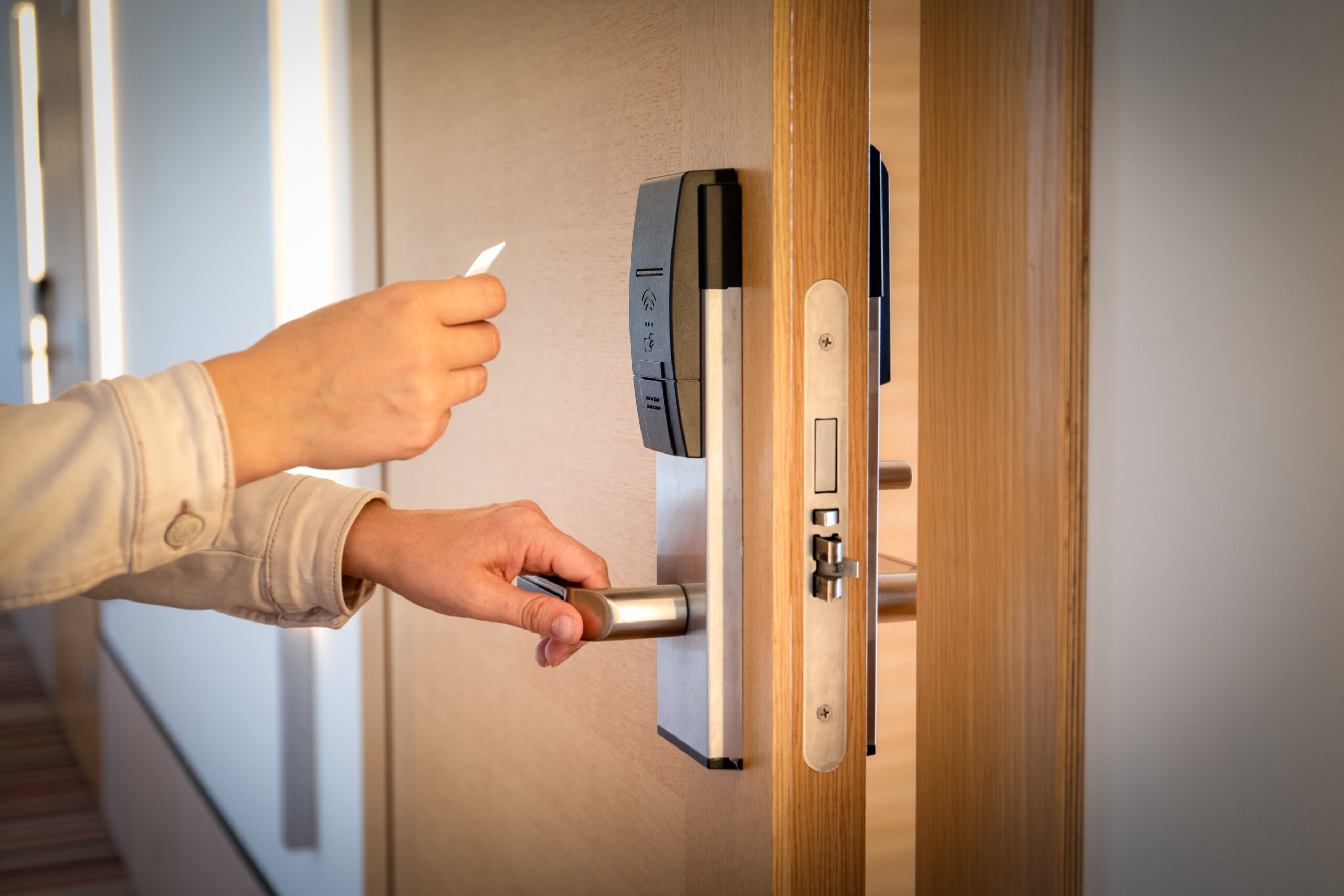
What causes Hotel RFID Key Cards to be damaged?
Hotel RFID Key Cards are essential to guest access systems in the modern hospitality industry. These small but vital devices provide seamless entry and exit to guest rooms, enhance security, and reduce front desk wait times. However, damage to these cards leads to guest frustration, increased hotel costs, and the need for frequent replacements. By understanding the common causes of key card damage, hotels can extend the life of their cards and provide guests with a better experience while minimizing operating costs. We’ve summarized some of the top factors that cause RFID key card damage and shared practical solutions and insights to help hotels optimize the durability of these essential access tools, empowering you with the knowledge to make informed decisions.
The Technology Inside Hotel RFID Key Cards and Its Susceptibility to Damage
RFID key cards are not just pieces of plastic. They are embedded with an antenna and a microchip, which are the heart of the card’s functionality. These components communicate with the hotel’s access system, allowing guests to enter their rooms. Unlike magnetic stripe cards, which can be damaged by simple scratches or dust, RFID cards rely on the structural integrity of these delicate internal components. The antenna and chip are housed just beneath the card’s plastic surface, making them susceptible to breakage or signal interference when bent, flexed, or exposed to certain conditions.
For instance, a large resort reported that high guest turnover often led to key cards being used repeatedly, with frequent re-encodings causing wear on the card’s structure. Over time, such repeated handling by numerous guests can degrade the card’s components, especially those made with lower-grade materials. To address this, some hotels now opt for cards with reinforced edges and more resilient materials to better protect the internal components and improve the card’s lifespan. This proactive investment has proven cost-effective, reducing card replacement rates by nearly 30% over a year and reassuring that proactive measures can lead to significant cost savings.

Physical wear and tear is the most common cause of damage
Physical wear and tear are among the most common causes of RFID key card damage in high-traffic hotels. Each day, guests handle these cards in various ways—tossing them into pockets, wallets, or bags with other items that can cause scratches or bending. Even seemingly minor actions like inserting the card into a wallet with coins or keys can result in surface scratches that, over time, affect the RFID card’s ability to communicate properly with the access system.
Research shows that guests who traveled with multiple electronic devices and personal items in pockets or purses were likelier to report issues with their key cards. Some hotels have addressed this by offering hard-shell key card holders or advising guests at check-in on proper handling practices. By engaging guests in the process and educating them on the importance of proper key card handling, hotels can protect their RFID cards from frequent physical damage and reduce the need for replacements, ultimately leading to more efficient use of resources and an improved guest experience.
Magnetic Interference from Electronic Devices
With nearly every guest carrying a smartphone or other electronic device, magnetic interference has become an increasingly relevant issue for hotel RFID key card. RFID key cards can experience signal disruption when placed near these devices, preventing them from properly interacting with the hotel’s lock system. Some hotel managers have even reported higher failure rates with RFID cards in rooms near high-tech event centers where guests bring multiple devices, often stacked with their key cards.
To help mitigate magnetic interference, hotels can implement small but effective strategies, such as placing reminder signs at check-in or providing special cardholders. Some card manufacturers have recently begun offering RFID cards with improved magnetic resistance. These cards are specifically designed to minimize interference from nearby electronics, ensuring that the card’s functionality is not affected. Such cards have significantly reduced failure rates when used in high-tech or conference-heavy hotels, allowing guests to enjoy a more seamless experience with fewer interruptions.

Environmental Exposure and Its Effects on Card Performance
Environmental factors, including temperature, humidity, and water exposure, are major contributors to RFID key card damage. In warmer regions or during peak summer months, cards left in direct sunlight or cars can experience warping, causing permanent damage to the microchip and antenna inside. Hotels in coastal or tropical regions, where humidity and temperature are consistently high, report higher card replacement rates due to these environmental stressors.
For example, a beachfront hotel reported that their replacement rate nearly doubled during peak summer months when high temperatures and humidity made cards more susceptible to damage. To address this, the hotel began using heat-resistant RFID cards that maintained functionality under intense sun exposure. Additionally, the hotel distributed waterproof card holders for guests engaging in water activities. By adapting to their specific environmental conditions, hotels can significantly reduce the impact of temperature and humidity on card durability, resulting in fewer disruptions and improved guest satisfaction.
High-Turnover Hotel Rooms Increase RFID Key Card Wear
RFID key cards in rooms with high turnover rates experience increased wear. Key cards are passed from one person to another with each new guest, often more frequently than in rooms with lower occupancy rates. This repeated use accelerates card wear and can cause premature card failure. Hotels near airports or in busy metropolitan areas tend to experience increased wear on RFID cards due to high turnover rates, with guests frequently checking in and out.
Case studies have shown that hotels could reduce card failure rates by 40% despite high guest turnover by switching to more durable cards with reinforced materials. Some hotels are experimenting with multi-use RFID solutions that allow digital smartphone access, reducing the need for physical cards in high-turnover environments. This approach reduces wear on physical cards and provides a modern, tech-savvy experience for guests who prefer the convenience of mobile access.

The Right RFID Card Material Quality Is Critical
The materials used in manufacturing RFID cards are key in determining their durability. High-quality cards with sturdy plastics and flexible electronic components last longer, while cost-effective alternatives are more susceptible to bending, scratching, and other damage. For hotels, the choice of materials can significantly impact guest satisfaction and replacement costs.
In the United States, a hotel chain that initially chose low-cost RFID cards found that they were replacing cards at an alarmingly high frequency. After switching to a supplier that specializes in high-quality materials, the hotel saw a significant reduction in replacement needs and reduced annual card-related expenses by more than 25%. Although high-quality RFID cards have a higher upfront cost, the long-term cost savings and improved guest experience make them a smart investment for hotels looking to reduce operational inefficiencies and enhance the quality of service.
Guest Handling Habits and Preventive Measures for RFID Key Card Longevity
Guest handling practices are another factor that can influence the lifespan of RFID key cards. Many guests unknowingly damage their cards by bending them, scratching them with sharp items, or storing them next to electronic devices. Studies have shown that nearly 70% of hotel guests store their key cards with other items that can cause damage, such as keys, coins, or mobile devices.
Hotels can play an active role in reducing card damage by educating guests on proper handling. Some establishments provide small protective sleeves at check-in, while others display signage reminding guests to keep their RFID cards separate from electronics. In addition, encouraging guests to store their cards in designated holders, particularly when participating in activities that could expose them to physical stress, can greatly increase the lifespan of these cards. Simple steps like these protect the card and enhance the guest experience, as guests not burdened by card malfunctions tend to rate their stay more positively.

A Proactive Approach to Preserving Hotel RFID Key Cards
The hospitality industry depends on reliable and efficient access solutions, and RFID key cards are at the forefront of providing secure, convenient room entry. While these cards are highly effective, they are also vulnerable to various damaging factors, including physical wear, magnetic interference, environmental exposure, high turnover rates, and suboptimal handling practices. By investing in high-quality cards, educating guests on best practices, and adapting to specific environmental challenges, hotels can extend the lifespan of their RFID key cards, minimize operational interruptions, and deliver a better overall experience to guests.


